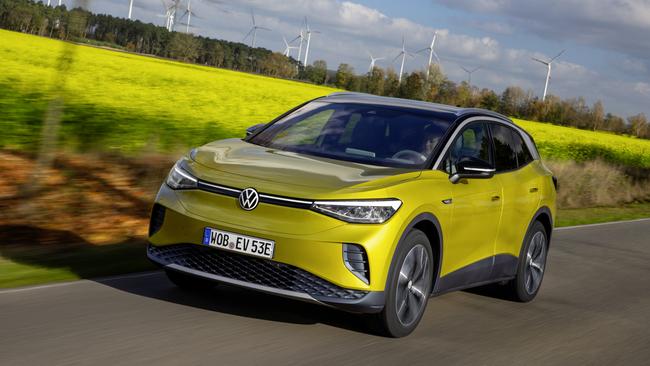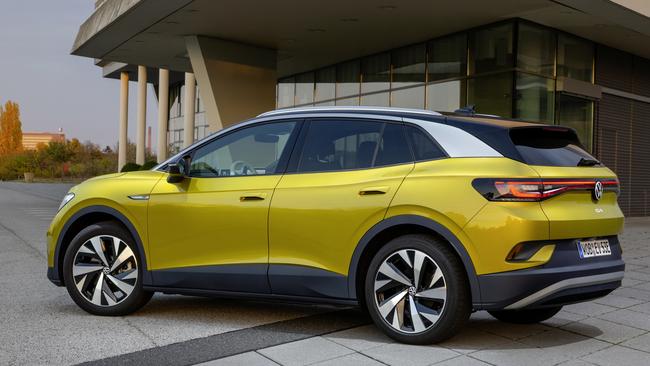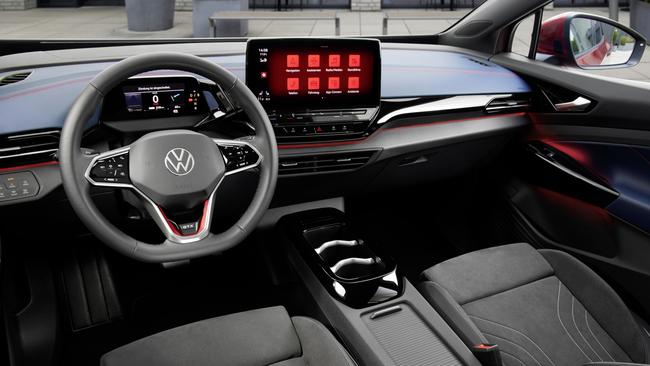2021 Volkswagen ID.4 review: VW’s electric future bestseller
This new car is being hyped as one of the best and most important vehicles coming out of Europe, but Aussies are set to miss out for one important reason.
New Cars
Don't miss out on the headlines from New Cars. Followed categories will be added to My News.
Volkswagen is counting on the ID.4 to convert EV-curious customers everywhere into battery-power believers.
As with the Beetle in the past and the Golf in the present, this new crossover is designed to anchor the German car-making giant’s line-up in the future.
The brand plans to produce 1.5 million EVs in 2025, and the ID. 4 is sure to be the top seller.
But it’s not coming to Australia any time soon, as VW’s Wolfsburg headquarters is prioritising EV supply to markets where governments have legally binding national emissions targets.

That’s a shame, because the ID.4 is exactly the kind of EV that could tempt many Aussies to wave goodbye to internal-combustion engine power.
It’s the right size, the right shape and the right price.
It’s also good looking, practical, comfortable, cheap to run and fun to drive, as we discovered in a 700km road trip around Italy.

Though similar in overall size to popular crossover SUVs such as the Toyota RAV4, the smoothly shaped ID.4 is a little lower.
The five-seater is spacious inside and has a big cargo compartment.
At first glance the design of the instrument panel seems stripped back to the basics, but it has all the latest infotainment and driver-assist tech.
In Italy, ID.4 prices are in the same ballpark as top-end versions of the Volkswagen Tiguan.
The cheapest ID.4 is about the same money as the Tiguan R-Line, which costs about $54,000 and is reportedly the best-selling model in the line-up.

The ID.4 we tested was the more expensive Pro Performance, with more driving range and power. In Italy it costs a little more than the diesel Tiguan R-Line.
The Pro Performance has a 150kW electric motor driving its rear wheels and a hefty 77kWh battery pack.
Performance is strong, but not startling. The ID. 4 is very quiet, even by EV standards, and super smooth to drive at freeway speeds.

The underfloor battery of the ID. 4 means it has a very low centre of gravity.
This gives it sharper, sportier handling than fuel-burning rivals. It also has a tight turning circle for its size, thanks to its rear-drive layout.
The suspension does a good job of smoothing out the bumps.
When it comes to charging, the VW is quicker than the average EV.
It can take up to 11kW from an AC wallbox, charging from empty to full in a little more than eight hours.
It also accepts up to 125kW from a DC fast-charger, so a 10-80 per cent battery top-up takes 34 minutes.
Real-world range between charges during our time with the VW was about 400km, although it was more efficient in town.

The energy consumption we recorded was in the 15 to 20kWh/100km range.
With average Australian domestic electricity prices at about 25 cents per kWh, this translates to a cost of $3.75 to $5 per 100km.
So include cheap running in the lengthy list of things Australians would like about the ID. 4 – if only they could buy it.
VW ID.4 PRO PERFORMANCE VITALS
Price: From about $55,000 (est)
Motor: Single synchronous permanent magnet; 150kW/310Nm
Efficiency: 17.1-17.8kWh/100km
Safety: Auto emergency braking, adaptive cruise control, blind-spot alert,
lane-keep assistant
0-100km/h: 8.5 secs
BUT WAIT, THERE’S MORE
The VW ID.3 is among the world’s most affordable small EVs, and one of the best.
In Europe the most basic versions cost the same as a Nissan Leaf, which starts at about $50,000 in Australia.
The ID.3 is vastly better than the Leaf. The cabin is roomier and better equipped, the design is more attractive, charging is faster and it’s more fun to drive.
Unlike some rivals, it is purpose-designed for battery power, with a stubby nose and a long, flat-floored cabin.
Even though its single e-motor is somewhere under the cargo floor, luggage room is similar to other small hatches. On the road, the ID.3 is really quiet.
The suspension delivers a firm but comfortable ride, and the VW handles the curves neatly. The steering is accurate and the brake pedal feels more natural than some EVs.
Though top speed is capped at 160km/h, acceleration is brisk and seamless.
It’s simpler to drive than petrol cars. Settle into the driver’s seat, press the brake pedal and the VW is almost ready to roll. Twist the selector knob beside the speedo screen for forward or reverse, and press the accelerator to get moving.
The ID.3 we drove had the mid-level 58kWh battery. This gave it a real-world driving range of close to 300km on the motorway and 400km-plus in mixed city driving.
Its energy consumption was about 14kWh/100km in town and 20kWh/100km at high speed.
When the battery doesn’t have much left to give, a fast DC charger will take about 30 minutes to add 250km of range.
This is a car that doesn’t give the picky critic a lot to whine about. VW has created an EV for the masses that’s likeable, practical and relatively affordable. Sadly, for Australians, it’s also unavailable for now.
Originally published as 2021 Volkswagen ID.4 review: VW’s electric future bestseller


